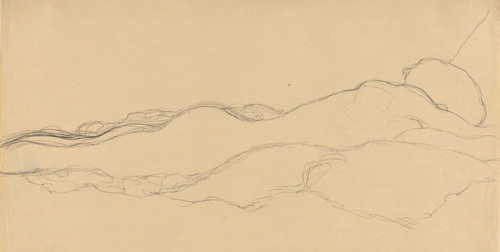
It is one thing to admire a work of art, quite another to immerse yourself in the surroundings that led to its creation. The Klimt Villa makes the latter possible.
The location helps you get so close to the person and artist that was Gustav Klimt that you can almost tweak his beard (inadvisable).
- The actual location of Klimt’s final studio
- He worked here from 1911 to 1918
- Studio reconstructed based on original photos
- Explores his life, his works, and the people involved in both
- Purchase a Klimt ticket package* for Vienna
- Places with his works plus discounts
- See also:
- One-time free entry with a Vienna Pass
- Klimt in Vienna
- Permanent Klimt exhibition at Upper Belvedere
The villa’s history

(The villa as seen from the road)
The building housing the studio is not quite what you might expect: a neo-Baroque two-storey house with broad stone steps and decorated iron balustrades. All in pristine, orderly condition. And not a hint of gold leaf in sight.
The location looked quite different when Klimt rented it for use as a studio in 1911: just a one storey, Biedermeier cottage on Feldmühlgasse with a large garden full of flowers and fruit trees.
The simplicity and relatively rural location (at the time) attracted Klimt in the first place.

(Gustav Klimt’s painter’s smock from around 1905; Wien Museum Inv.-Nr. M 8641, Photo: Birgit und Peter Kainz, Wien Museum; reproduced under the terms of the CC BY 4.0 license)
The ambience influenced his later works, which were often characterised by the colours and motifs he might have seen among the blooms and blossoms outside.
For example, Klimt painted Adele Bloch-Bauer II (famously once owned by Oprah Winfrey) here. Oprah subsequently sold it to a private buyer for a rumoured sum of around US$150 million, which makes the work one of the most expensive of all time.
Just a day after Klimt’s death in 1918, the Fremden Blatt paper even headlined their report with the studio’s location: “The painter from the Feldmühlgasse.” They began the article with this description (my rough translation):
Feldmühlgasse in the 13th district. Few know of it, and fewer still know of the remote house tucked away behind the trees of a secluded garden in Unter St. Veit.

(Gustav Klimt, Auf dem Bauch liegender weiblicher Akt, 1916–1917, Wien Museum Inv.-Nr. 74930/219, excerpt reproduced with permission under the terms of the CC0 licence)
A few years after Klimt’s passing, the owners added an upstairs to the villa and redecorated. Although the exterior changed considerably, the interior layout of the lower floor remained largely untouched. In 1954, the house fell into public hands, eventually serving as a school building.
By the 1990s, the authorities seemed ready to sell off the location for development, declaring that the villa was not the one that housed Klimt’s studio.
It took some ten years to correct the error, and we have the efforts of a private initiative to thank for ensuring the studio remains preserved, state-owned, and accessible to the public.
Inside the Klimt Villa
Inside is a mix of exhibition and reconstructions. English language information displays, reproductions of Klimt’s works, correspondence, and replicas offer insight into his life, art, clients, and models.
Perhaps the most impressive area is the main studio and reception room, both reconstructed to look precisely like the original rooms did, complete with discarded artist’s smock, splattered palette etc.

(Inside Klimt’s studio; press photo © Photo Tiller)
Both the rooms and their contents exactly match reference photos of Klimt’s occupancy, pretty much right down to the last dot of paint.
You can picture yourself as the artist, looking for inspiration through the huge garden windows of the studio. Or stand in the reception room, with its oriental theme, and imagine receiving such guests as Arthur Schnitzler or Egon Schiele.
Much of the plants, colour, and life that so characterized Klimt’s garden (and influenced his work) have gone, but you can still find, for example, old rose bushes likely once touched by the same hand that painted The Kiss.
Tickets & visitor tips
At the time of writing, an entrance ticket costs €10 for adults, with concessions. Alternatively, a Vienna Pass (my review) allows one-time free entry.
The location is Viennese suburbia, but you’re close to the Schönbrunn Palace complex. And you can pay your respects to Klimt at his grave in the Hietzinger Cemetery (a 30 minute walk away from the villa, for example).
How to get to the Klimt Villa
The villa is a short 5-6 min walk from the Unter St. Veit subway station on the U4 line that travels out from, for example, Karlsplatz or Schwedenplatz in the centre.
Tram line 10 and bus line 54b also run nearby (get off at the Verbindungsbahn stop and it’s a 2-3 min walk).
Address: Feldmühlgasse 11, 1130 Vienna | Website